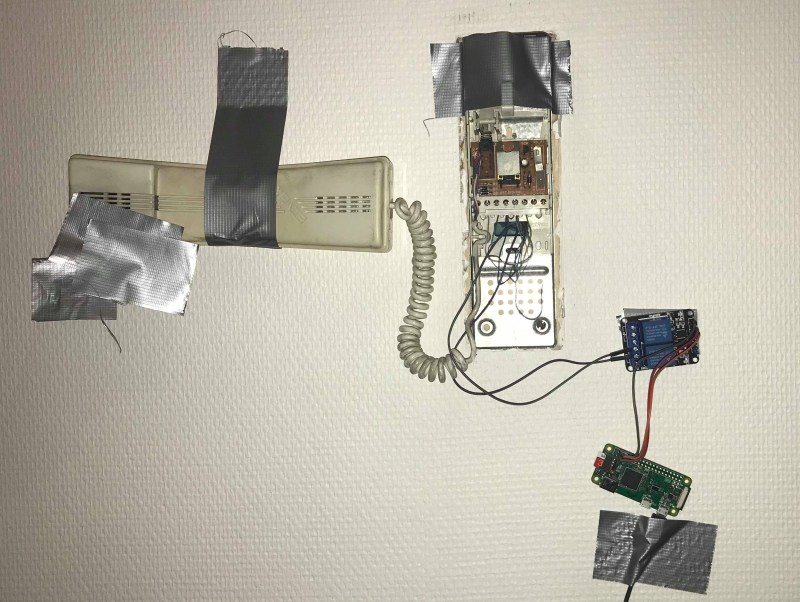Never underestimate the quick and dirty hack. It’s very satisfying to rapidly solve a real problem with whatever you have on hand, and helps to keep your hacking skills sharp for those big beautifully engineered projects. [Guillaume M] needed a way to remotely open his apartment building door for deliveries, so he hacked the ancient intercom to be operated via Telegram, to allow packages to be deposited safely inside his mailbox inside the building’s front too.
[Guillaume] needed to complete the hack in a way that would allow him to return the intercom to its original state when he moves out. Opening the 30-year-old unit, he probed a row of screw terminals and identified a 13V supply, ground, and the connection to the buildings’ door lock. He connected the lock terminals to a relay, which is controlled by a Raspberry Pi Zero W that waits for the “open” command to be sent to a custom Telegram Bot.
To power the Pi, [Guillaume] connected it to the 13V supply on the intercom via a voltage divider circuit. Voltage dividers usually make lousy power supplies, since the output voltage will fluctuate as the load changes, but it looks as though it worked well enough for [Guillaume]. The intercom had a lot of empty space inside, so after testing everything was packed inside the housing.
If you want to achieve the same with an ESP8266, there’s a library for that. Just keep in mind that being dependent on web servers to open critical doors might get you locked out.















This is an elvox intercom system. Good job on the project but your wiring is wrong. According to the schematic the door opens when you short pins 6 and 7. 3 and 4 are always on short by default.
Hey! I tried that, but I think my intercom is not wired like in the schematic :(
A voltage divider to power a Raspberry Pi? That has to be the most stupid thing i have read today. That’s a great way to burn off a shitload of heat and fry the Pi as the load on the line changes (the Pi doesn’t use constant power) …
He could replace it later with a buck converter …
(Guillaume, nice hack : while you’re at it upgrading to an esp8266 and a single relay board, you may want to grab a buck converter from the same trusty chinese providers :))
This calls for a V2.0 of this project then! Thanks :D
I did this with an ESP8266 (D1 mini), a buck converter and a relay module just a couple of months ago. I flashed the ESP with Espurna to be able to control the relay via MQTT and to configure a timeout to lock the door after unlocking in the case of a connection failure, with zero coding. The main advantages of this setup is smaller footprint and smaller power consumption (you’ll want to minimize the stress on the intercom’s power supply). Worth noting is I found I had to add a big electrolytic cap across 5V and GND. Without it the ESP8266 power transients caused a whining noise on the intercom earpiece.
Telegram is a quick and powerful hacking tool… I made a bot to take photos of my security cameras with like 50 lines of code… Now my (old?) dad can see the cameras with a simple and secure “/whatever”.
Hey, this work for me :) Thank!!
Quick and Dirty? That picture looks obscene, but if it works it works.
Well, this picture shows the different components that I used, but it’s not the final form of this project where everything is squeezed inside the casing :)
Isn’t this a form of energy stealing if he is connecting the pi to the power line of that intercom which energy coasts probably will divided by all tenants living there?🤔